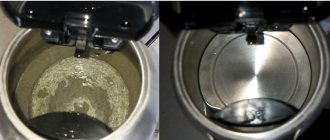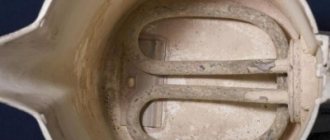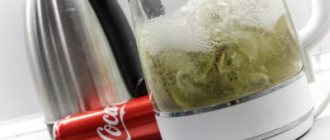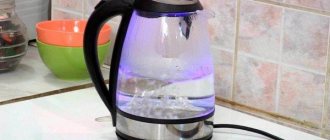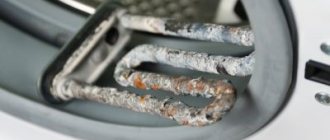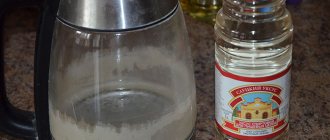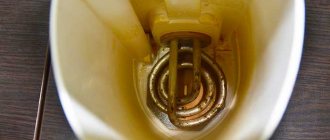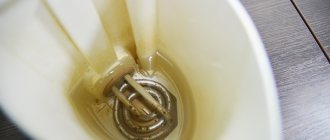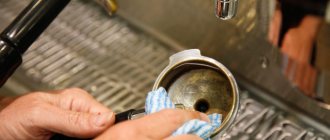Scale forms in any kettle - electric and regular. It accumulates on the walls in a thick layer, which is why the device copes worse with its main function.
Water from such a container cannot be considered clean. You can cope with the problem using inexpensive improvised means.
Read the article about how to remove scale from a kettle using citric acid using folk recipes, and how to remove lime deposits using household chemicals.
Can it be cleaned?
You can clean the kettle with citric acid. The layer that forms inside is salt deposits. They no longer dissolve in ordinary water. To destroy their hard shell, exposure to more aggressive substances is necessary.
Citric acid is the most accessible, safe and inexpensive remedy that helps to quickly cope with the problem. You can clean the kettle with lemon. It does not harm its walls, does not cause them corrosion or oxidation.
The preservative works exclusively on the surface, dissolving solid deposits. In the future, you can use such a device without danger to your health.
Cleaning the washing machine
Systematic cleaning of the washing machine with citric acid will save you from rapid aging of equipment and rapid breakdown. Hard water, which is used when washing clothes, after some time leaves a large amount of salts that settle on the heating element and other important parts of the mechanism. Multilayer scale begins to wear out the machine and the washing process becomes ineffective.
Cleaning steps
To descale your washing machine with citric acid, take the powder itself and a small piece of dry and clean cloth. The process occurs in stages:
- check the drum for the absence of things in it, since citric acid can discolor the fabric by dissolving the paint;
- a machine with a washing capacity of up to 7-8 kg requires 90-100 g of powder, for smaller equipment (up to 4 kg) 50-60 g is enough;
- It is better to pour the monohydrate into the drum and into the powder tray;
- choose the longest possible mode with all the main processes - soaking, spinning, rinsing at a temperature of no more than 60°C;
- at the end of the washing process, check the condition of the drum cuff, where dirt and sediment may be found in the flap, which is wiped with a clean cloth;
- You should then clean the drain filter from any remaining large pieces of scale and dry the powder container.
It is permissible to clean the washing machine with citric acid up to 3 times a year with high water hardness. Softer water does not have such a devastating effect on the machine, so cleaning the washing machine with citric acid in this case is allowed about 2 times a year. The preventive measure is carried out after every 30th wash.
How to remove lime deposits at home?
If the plaque is very dense and firmly fixed on the surface, you can deal with it in the following way:
Drain the kettle. Rinse it with warm water, you can walk over the surface with a sponge.- Fill the device with water. It should completely cover those areas where salt deposits are visible.
- Add citric acid. For each liter you will need 20 g of powder.
- Place the device on the stove or plug it into the network. Wait until it boils. If the kettle is electric, then when it turns off, you need to wait 10 minutes and turn it on again. Boil water in a regular kettle for 5 minutes.
- Leave the solution inside to work.
- Drain the water and remove the remaining sediment with the hard side of the sponge.
- If the plaque has not been completely removed, the procedure must be repeated.
- To remove any remaining product, you need to pour clean water into the kettle, boil it and drain it. After this, you can use the device as usual.
If the scale layer is small, then you can do without boiling. Features of the procedure:
- fill the kettle with clean warm water;
- add citric acid - 10 g of powder is required for 1 liter of water;
- leave the kettle to soak for at least 5 hours; if possible, leave the citric acid solution in the container overnight;
- pour out the water, rinse the device by going over it from the inside with a sponge.
This procedure will help you cope with plaque if it is barely noticeable.
The video will show you how to descale a kettle with citric acid:
What to add to enhance the effect?
To enhance the effect, the following substances are used together with citric acid:
Salt. For every 10 liters of water you will need 10 g of salt.- Soda. For a 3 liter kettle you will need 30 g of citric acid and 3 tablespoons of soda. Add them together, then heat the water without bringing it to a boil. It will take about an hour for the scale to completely dissolve.
- Vinegar. If the layer of limescale is thick, you can add 3 tablespoons of 9% vinegar to the citric acid solution. These substances mutually enhance each other's effects. The solution is boiled, left to act for an hour and drained.
For which teapots is it not suitable or suitable?
The market is filled with different teapots. Even in one family, several types of equipment can be used at once, and accordingly, care can be different. Cleaning a kettle from scale with citric acid may not be suitable in every case. There are materials that can deteriorate when interacting with an acidic environment.
Not suitable:
- Enameled teapots cannot be cleaned with lemon or other acid-containing products. The enamel becomes thinner and the equipment will quickly become unusable. In this case, soda is more suitable for cleaning. A tablespoon of the product should be dissolved in water, boiled and drained, and then wash the product. Folk remedies include peeling apples and pears. Simply place the fruit scraps in a kettle of water and boil them. A small amount of acid washes away the scale. The method works only for minor contamination;
- Plastic electric ones - here you need to be more careful with acids and use more gentle products. If you don't know how to clean an electric kettle, try making a weak solution of citric acid and leaving it for a couple of hours. The appearance of such products is tidied up using soda dissolved in water. You can make a thin paste, apply it to the stains and after a while, gently rub. And, of course, no vinegar or direct aggressive effects of acids - plastic does not like this. It should be noted that plastic kettles are cleaned much faster than their metal or enamel counterparts.
Fits:
- Metal ones can be easily cleaned with lemon or vinegar. You can boil an acid solution in them, this will not affect the quality of the device. Baking soda diluted in water is also suitable for washing. Do not use abrasive materials, only soft brushes, sponges and cloths;
- Electric ones made of heat-resistant glass - the use of acid will not only quickly clean such a kettle, but also give it shine. Usually there is no sediment left on the glass, but the heating bottom may be dirty. Boil water with acid, rinse well and wipe from the inside. Citric acid will help remove traces of dirt from the outside of the electric kettle. And of course, no hard brushes or metal sponges;
- Thermopot is a very convenient thing to have in the house, but there are difficulties in cleaning it due to the structure and weight of the thermopot. But here citric acid comes to the rescue. It is more effective than baking soda and does not have a strong odor like vinegar. You need to pour a packet of acid into the thermopot and boil the solution. Drain the water and wipe the walls and bottom with a soft cloth. A final boil can be carried out.
Enameled
Plastic
Metal
Electric glass
Thermopot
How often should I clean?
The kettle needs to be cleaned regularly. If you carry out the procedure at least once a month, scale will not form. The cleaning time depends on the quality of the tap water.
If it is soft, then scale forms slowly. In this case, treatment can be carried out once every 1.5-2 months. If the water is hard, limescale deposits quickly. Therefore, preventive cleaning of the device is carried out once every 3-4 weeks.
Citric acid does not harm the kettle even with frequent contact with its walls.
How harmful is limescale from a kettle?
Finally, I would like to say that scale is a complex mixture consisting of metal salts and chlorine. Since water for the kettle is most often drawn from the tap, a large amount of scale forms on the heating element.
The dangerous compounds that make up the white plaque have a toxic effect on our body. They get inside through boiled water and are not tasted, but cause colossal damage to health.
As a result of regular consumption of water with scale, liver and kidney diseases develop, and problems with the stomach and intestines arise. Therefore, it is recommended to get rid of scale every month, at least.
Citric acid or juice are quite effective products that, when used regularly, protect the kettle from the formation of white deposits. The device will always be clean and will last a long time, and your health will remain in perfect order.
Alternative remedies
Citric acid is not the only means to combat scale. You can cope with it with the help of other substances that can be found in every home. Another option is to purchase a special detergent composition in the store.
The best folk recipes (with proportions)
The following substances effectively remove lime deposits in a kettle:
Sprite. This carbonated drink helps to quickly deal with plaque, without harm to the device itself.
The drink is poured into a kettle and left open for 20 minutes to allow the gas to escape, after which the liquid is brought to a boil and poured into the sink. It is not recommended to use Coca-Cola or Fanta, as they can stain the plastic kettle.- Soda and vinegar . They are used in turn. First, the kettle is boiled with a soda solution (20 g per 1 l). After which it is drained and vinegar solution is poured in (5 tablespoons per 5 liters of water). This recipe helps to cope with even the most stubborn scale.
- Oxalic acid . It is poured into the device at the rate of 10 g per 2 liters of water. The solution is brought to a boil, allowed to cool, and then poured into the sink.
How to clean using household chemicals?
You can deal with plaque using specialized household chemicals. The most effective formulations include:
- Topper for descaling a kettle. Pour 1 liter of water into the kettle and add 100-120 ml of cleaning product. Heat the water to 50 degrees and leave for half an hour. The solution is poured, rinsed thoroughly and the container is boiled. Cost 250 ml – 145 rubles.
- Mellerud. Dilute 60 ml of cleaning product in 250 ml of water, pour into a kettle, bring to a boil and turn off. After 15 minutes, the liquid is drained. The cost of 500 ml of solution is 270 rubles.
- Cinderella "Antinakipin" . Pour 2 liters of water into the kettle, pour the contents of 1 sachet into it and boil for 30 minutes. Then leave the product to act for 3 hours, drain the composition, and wash the dishes themselves with clean water. The cost of a 100 g bag of powder is 30 rubles.
Benefits of Citric Acid
The list of available means for descaling is large and includes, in addition to lemon juice, vinegar, soda, and carbonated water. But many people prefer this particular powder, for which there is good reason.
The product is the result of a chemical reaction and looks like a crystalline powder. The taste is sour. AHA acid (that’s exactly what its name sounds like in chemistry) is a 3-basic carbonic acid, found naturally in fruits (mostly in citrus fruits).
There is about 6 g in lemon, 7 g in lime, and a little more than one gram in black currant (content per 100 g of product).
But contrary to popular belief, acid is not produced from lemons. It is obtained through the process of biosynthesis from sugar-containing raw materials (hydrolysates of corn, sweet potato, cassava). “Limonka” is odorless, colorless, and dissolves well in water.
In the food industry it is used as a flavoring additive (designation E 330).
One of the reasons for the popularity of the powder as a means for descaling at home is the absence of a specific odor and harmlessness. Unlike a solution with vinegar, which cannot be worked with without taking certain precautions, “lemon” is simple and easy to use.
The benefits also include:
- efficiency. Removes plaque well and quickly, even old scale;
- availability of the product (sold in any supermarket);
- cheapness. Sachets from 5 to 100 g, cost varies from 10 to 50 rubles;
- organic composition;
- A small amount is required to prepare the cleaning solution;
- Suitable for cleaning kettles, thermopots, dishwashers.
It is believed that the product can be used for dishes made of any material (glass, enamel, stainless steel, plastic). Although many housewives note that glass and plastic models must be cleaned carefully, using not too concentrated solutions and excluding boiling.
We can also use the powder for electric kettles, but only if the heating elements are made of high-quality stainless steel. She doesn’t care about an acid solution, but heating elements of cheap models made of “left-handed” alloys often become deformed and become unusable. So, when cleaning devices operating from the network, they act with acid very carefully and correctly, following the instructions.
Features for different surfaces
Different materials react differently to cleaning. In order not to spoil the dishes, you need to consider the following points:
glass - it is not afraid of contact with citric acid, but it cannot be rubbed with a wire brush, as small scratches will appear on the surface;- plastic - the device reacts normally to treatment with lemon juice, but aggressive acids should not be used to clean it;
- metal - the material is resistant to citric acid, it can be rubbed with soft brushes, but you should not try to remove scale with a knife or other sharp object.
Gentle cleaning with lemon
Using lemon decoction, you can clean a glass or plastic kettle from scale, as well as carry out preventive cleaning of the body.
Algorithm of actions:
- In any container, prepare a decoction: 1 unpeeled lemon, cut into slices, per 2 liters of water. Bring to a boil, simmer for 5–7 minutes.
- Without removing the lemon, pour boiling water into the kettle.
- Leave for 2-3 hours until the liquid has cooled.
- Clean the housing using a soft sponge. If the deposit remains, refill the solution, first bringing it to a boil in another container.
The method of descaling with boiled lemon decoction is safe for all types of teapots. The solution gently corrodes plaque, makes it loose, and helps clean the body without resorting to caustic chemicals or harsh methods.
Helpful information
To ensure that the procedure for removing lime deposits is effective and safe for health, you need to follow simple rules:
- You should not drink water from the kettle immediately after the procedure. First you need to boil it with clean water and drain it. Only after this can the device be fully used.
- All household members should be warned that the kettle is filled with descaling liquid. This will avoid poisoning.
- Once the cleaning solution boils, do not immediately pour it into the sink. The longer it stays inside, the higher the cleaning efficiency.
You can learn about methods and methods for descaling here.
Scale prevention
The following actions can help minimize the risk of scale formation:
- Rinse the kettle daily with running water, using a soft sponge to remove any plaque that has accumulated during the day;
- after boiling water, do not leave the liquid in the device’s reservoir for a long time, pour it into another container;
- remove scale as soon as it begins to form, and not when it has formed a thick layer of deposits on the walls.
Scale damages not only the electric kettle. Find out how to remove lime deposits from your washing machine. This publication will tell you about descaling your Philips iron.
REFERENCE! The service life of an electric kettle depends on the frequency of use of the device and the degree of care for it.
Not only the internal areas and elements of the device need to be cleaned, but also the external surfaces: periodically wipe the body with a damp sponge dipped in clean water or soapy water, and your tea drinking will always be tasty and enjoyable.
How to clean the outside?
Very often teapots, now we are not talking about electrical appliances, lose their appearance. An enameled or metal product becomes stained with grease, carbon deposits and even rust appear. What to do in this case? I would like all kitchen utensils to shine with their pristine shine and cleanliness, and not scare away with their terrible appearance.
Don't worry, there are tips for this case too. As before, you will need citric acid. Small oil stains and burnt fat can be removed with a lemon peel. Simply take a lemon peel or a citrus slice and rub onto the affected areas. Stains will come off easily, and you can easily wash the dishes with a soft sponge.
If the dirt on the surface is too serious, then prepare a special cleaning solution in a large container. You will need a large container that can completely immerse the kettle. Add 100-150 grams of citric acid to warm water, then immerse the kettle there. Leave for about an hour. It is important to remember here: the hotter the water, the more acid, the faster the cleaning process will take place.
Old stains that periodically appear after cooking can be easily removed using a “paste” of acid and baking soda. We talked about the preparation of the mixture and the consistency of the cleaning solution above.
Descaling your coffee machine and coffee maker
If you love coffee and you have a coffee machine at home, then sooner or later it also needs to be cleaned of scale and sediment. It doesn’t matter what brand it is, you should always clean it, be it capsule, geyser, pod or carob.
It is recommended to clean the coffee machine once every three months, because in addition to hard water, coffee oils also accumulate in it. How to know when it's time:
- coffee takes a long time to prepare;
- the drink flows out more slowly, the stream has become thinner, scale has formed on the tube;
- the taste of the coffee has deteriorated and an aftertaste has appeared;
- the smell of coffee has changed;
- the coffee machine began to “abuse” energy;
- white and light gray impurities can be traced in the drink;
- previously unknown sounds are heard from the operation of the device;
The coffee machine can be cleaned in different ways: with improvised means or purchased ones.
In everyday life, this is descaling with vinegar or citric acid.
Steps for descaling with vinegar:
- Make a solution in the ratio of vinegar to water (one to two).
- Pour this mixture into the water tank.
- Turn on the coffee maker.
- Wait until it warms up and reaches maximum temperature (about 15 minutes) and turn it off.
- Leave for 10 hours for the product and scale to interact.
- Pour the solution into the sink and wash the equipment very thoroughly several times.
- Prepare a couple of cups of coffee to remove all the remaining residue from the coffee maker.
Advice! Don't skimp on water and make ten cups of coffee instead of two to kill the smell and taste of vinegar.
Steps for descaling with citric acid:
- Combine two packs of citric acid (40 g) with water (1 l) and fill the coffee machine.
- Turn it on, and after boiling, turn it off.
- Wash all parts in this solution.
- Repeat all steps several times.
- Make a couple of cups of coffee to cleanse the residue.
Traditional methods are wonderful, but not everyone trusts them. Each coffee machine manufacturer offers descalers of one brand or another.
The products come in tablet form and come in bottles. It all depends on the brand and type of car.
You can also use a universal product - anti-scale agent - for cleaning the coffee maker.
It should also be said that many coffee machines have a self-cleaning function. Here you also need to carefully read the instructions. Each model has its own nuances during self-cleaning. Although everyone has the same scheme - fill the tank with solution, press the “Auto-cleaning” button. The coffee machine will do everything itself.
Cleaning scale from an iron
When scale and deposits appear on the iron, it is noticeable from two sources: firstly, it is visible visually, and secondly, after ironing, things are damaged and stained. Then the moment comes to choose whether to buy a new one or clean it.
To remove scale from the inside of the iron, two proven folk remedies will help us: vinegar and citric acid. The procedure is as follows:
- One packet of citric acid is dissolved in water and poured into the iron.
- The iron is connected to electricity and heated, then the effect of citric acid is enhanced and the plaque goes away.
- Such manipulations need to be done a couple of times and only then turn on the steam function so that all the liquid evaporates.
- When the iron has cooled, wipe the soleplate with vinegar.
- Then pour clean water, turn on the iron and iron any unnecessary cotton fabric, using the steam mode.
Turn on the iron and release steam until all the liquid is used up.
I can clean scale inside and plaque outside with professional products. These are universal (cleaning only inside), special ones intended only for irons (removing scale and plaque everywhere), as well as pencils for cleaning the surface and holes in the sole.
Everyone knows how to use a universal tool, but how to use a pencil? The procedure is simple, since a pencil is used to clean the surface, only the sole of the iron is cleaned with it. Having turned on the iron and prepared the old unnecessary fabric, we rub the underside of the device with a pencil. Using the steam function, we iron the fabric, thereby cleaning the nozzles and soleplate of the iron.
If your iron has a self-cleaning function, you can use it to remove scale. Each model has its own nuances, and for everything to go well, it wouldn’t hurt to read the instructions for using the self-cleaning function again.
Important! No matter how many stages there are of turning on and off the iron during self-cleaning, it must be in a vertical position and above a container into which water will flow without warning.
Sooner or later you will have to descale your iron even when using a very high-quality device.
Why does it work
Arina Piskareva
Laboratory employee of the Department of Bioengineering, Moscow State University
Scale is mainly composed of calcium and magnesium carbonate. When interacting with citric, acetic, orthophosphoric or other acid, sparingly soluble carbonates of alkaline earth metals are converted into readily soluble salts. For example, acetates. Therefore, acidic substances are effective in the fight against scale, and to enhance the reaction they need to be heated.
Soda, when interacting with water, produces carbonic acid molecules, which, in turn, react with insoluble calcium and magnesium carbonates, turning them into soluble bicarbonates. And they are easily washed off with water and removed with a sponge.
How to descale with soda water
- Suitable for any teapots, coffee machines, irons.
- Proportions: the vessels are filled approximately ¾ full.
- Plus: effective even with thick plaque.
- Disadvantage: a colored drink may stain the vessel. Therefore, to clean irons and white plastic electric kettles, it is better to use clear soda, including mineral water.
Open the bottle and wait until most of the carbon dioxide has evaporated.
Pour the soda into the kettle or coffee maker reservoir, hold for 15–20 minutes, and then boil.
Thanks to phosphoric acid and carbon dioxide, sodas do an excellent job of removing salt deposits.
Cleaning the dishwasher
The dishwasher also has an element that heats the water. Salt scales appear over time on these parts of the mechanism, and grease accumulates inside the dishwasher itself. The properties and effectiveness of citric acid as a home remedy for cleaning this household appliance is highly effective.
To tidy up your dishwasher, you need to do the same as for cleaning a washing machine with citric acid:
- The detergent compartment is filled with one sachet of powder – 25 g;
- the washing mode is activated at maximum water temperature;
- upon completion of cleansing, restart another mode without adding any products - to rinse the machine;
- at the end of the entire process, clean the filter, wipe the entire cabin cavity with a damp, clean cloth, including the seals and door.
Cleaning with Vinegar
Acetic acid is considered the most popular means of combating scale build-up at home. With its help you can clean not only a metal, but also a glass teapot. However, boiling water with vinegar for an electric kettle is strictly contraindicated.
For this procedure you need 100 ml of vinegar , mix it with a liter of water and pour it into the kettle, bring it to a boil over low heat, then leave for another 15 minutes . The most important rule: after such cleaning, you need to thoroughly wash the vinegar itself. To do this, you need to boil at least three portions of water.
How often is flushing required?
Many popular manufacturers of gas boilers such as Navien, Baxi, Ariston, Vaillant indicate the frequency of flushing the heat exchanger in their operating instructions. However, real operating conditions often make their own adjustments. The practice of connecting gas boilers to a heating system with hard water shows that the heat exchanger should be flushed every season. To avoid this problem in the middle of a cold winter, it is recommended to flush immediately after or before the start of the heating season. The following are characteristic signs that indicate that the heat exchanger of your gas boiler needs cleaning:
Gas consumption has increased
The resulting scale reduces the thermal conductivity of the heat exchanger, thereby forcing the gas boiler to burn more fuel to achieve the set temperature.
Burner always on
An increase in burner operating time may also indicate the presence of scale preventing normal heating of the coolant.
Rumble and interruptions in the operation of the circulation pump
Reducing the effective diameter of the heat exchanger channels makes it difficult to pump the coolant to the circulation pump. Its operation in maximum mode may be accompanied by hum and interruptions in operation.
Reduced pressure in the DHW circuit
A sign of the presence of a layer of scale in the secondary circuit of a double-circuit boiler can be a decrease in pressure in the hot water supply line.
If one or more of the above signs can be observed in the operation of your gas boiler, it is necessary to urgently flush it in order to avoid breakdowns of expensive heating system components and high costs for their repair or replacement.
Return to contents

